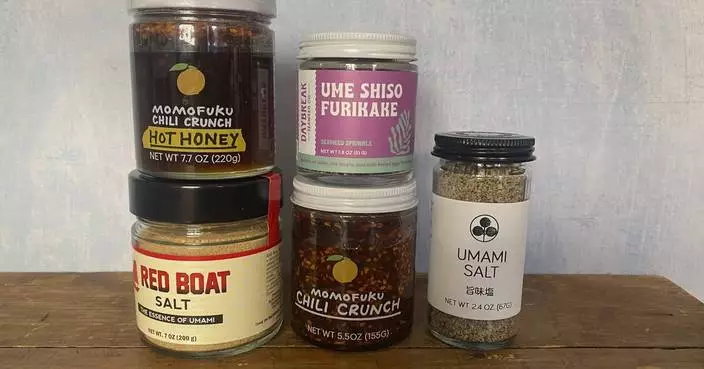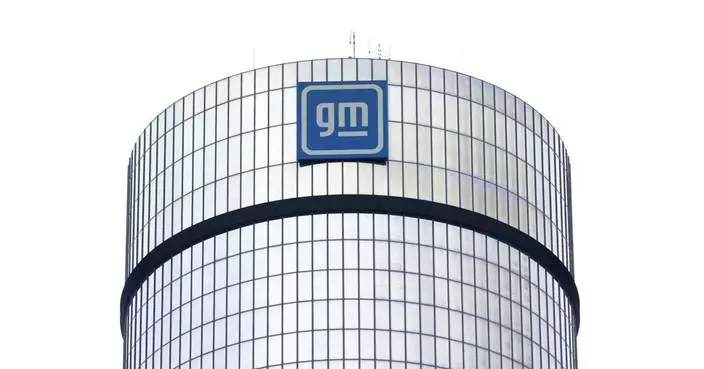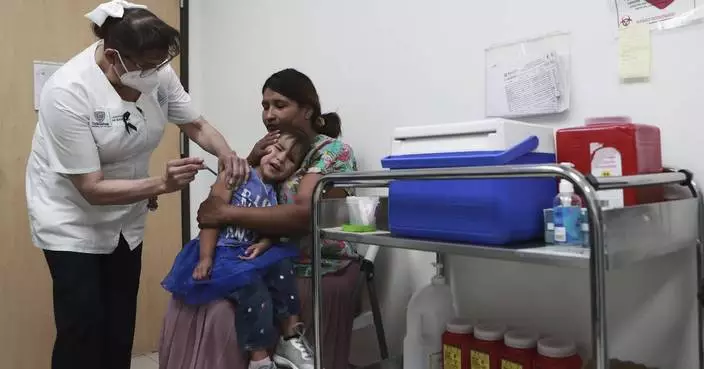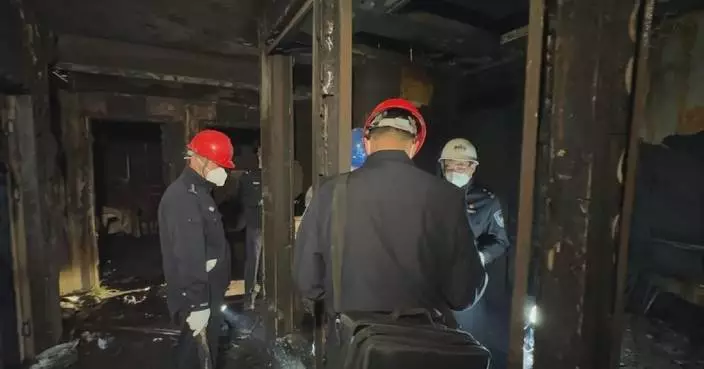A look at the injuries for Tiger Woods, who had surgery Tuesday on a ruptured left Achilles tendon.
—December 1994: Has surgery on left knee to remove two benign tumors and scar tissue.
—Dec. 13, 2002: Has surgery on left knee to remove fluid inside and outside the ACL and remove benign cysts from his left knee. Misses the season opener in 2003.
—August 2007: Ruptures the ACL in his left knee while running on a golf course after the British Open but is able to keep playing. Wins five of the last six tournaments he plays, including the PGA Championship for his 13th major.
—April 15, 2008: Two days after the Masters, has arthroscopic surgery on his left knee to repair cartilage damage.
—May 2008: Advised weeks before the U.S. Open that he has two stress fractures of the left tibia and should rest for six weeks, the first three weeks on crutches.
—June 24, 2008: Eight days after winning the U.S. Open, has surgery to repair the ACL in his left knee by using a tendon from his right thigh. Additional cartilage damage is repaired. Misses the rest of the season.
—December 2008: Injures his Achilles tendon in his right leg as he was running while preparing to return to golf.
—Nov. 27, 2009: Is hospitalized overnight with a sore neck and a cut lip that required five stitches when the SUV he was driving ran over a fire hydrant and into a tree.
—May 9, 2010: Withdraws from the final round of The Players Championship, citing a bulging disk. He later said it was a neck issue that caused tingling in his right side, and that it first became a problem as he began practicing harder for his return to the Masters a month earlier.
—April 10, 2011: Injures his left Achilles tendon hitting from an awkward stance below Eisenhower’s Tree on the 17th at Augusta National.
—May 12, 2011: Withdraws from The Players Championship after a 42 on the front nine. Is diagnosed with an MCL sprain in his left knee and a left Achilles tendon strain. He misses the next two months, including two majors.
—March 11, 2012: Feels tightness in his left Achilles tendon and withdraws after 11 holes of the final round in the Cadillac Championship at Doral. He wins in his next start at Bay Hill, his first PGA Tour victory since the scandal in his personal life.
—Aug. 24, 2012: Moves stiffly during the second round of The Barclays and later says he felt pain in his lower back, which he attributed to a soft mattress in his hotel room.
—June 13, 2013: Is seen shaking his left arm during the opening round of the U.S. Open. He later says it’s a left elbow strain that he injured while winning The Players Championship a month earlier. He misses two tournaments and returns at the British Open.
—Aug. 11, 2013: Says he felt tightness in his back during the final round of the PGA Championship.
—Aug. 21, 2013: Two weeks after the PGA Championship, he drops to his knees after one shot because of back spasms in the final round of The Barclays.
—March 2, 2014: Withdraws after 13 holes of the final round at The Honda Classic because of lower back pain and spasms, describing it as similar to what he felt at The Barclays.
—March 9, 2014: Plays the final 12 holes with pain in his lower back, saying it began to flare up after hitting out of the bunker from an awkward lie in the Cadillac Championship at Doral. He shoots 78, the highest score of his career in a final round.
—March 19, 2014: Withdraws from the Arnold Palmer Invitational because of the persistent pain in his back. He was the two-time defending champion.
—March 31, 2014: Has surgery in Utah for a pinched nerve.
—April 1, 2014: Announces he will miss the Masters and not return to golf until the summer.
—Sept. 16, 2015: Has a second microdiscectomy surgery to remove a disc fragment that was pinching his nerve.
—Oct. 28, 2015: Has a third surgery he describes as a follow-up to relieve discomfort.
—Feb. 3, 2017: Withdraws from the Dubai Desert Classic before the start of his second round with back spasms. He opened with a 77.
—April 19, 2017: Has surgery to fuse his lower back.
—May 30, 2017: Attributes an arrest on suspicion of driving under the influence when police find him asleep behind the wheel of a parked car as a reaction to prescription medication.
—March 4, 2019: Withdraws from the Arnold Palmer Invitational with what he describes as a neck strain that he has had for two weeks.
—Aug. 9, 2019: Withdraws after a 75 in the first round of FedEx Cup playoffs opener, citing a strained oblique.
—Aug. 27, 2019: Announces he had arthroscopic surgery the previous week to repair minor ligament damage in his left knee.
—Jan. 19, 2021: Announces he had a fifth microdiscectomy procedure on his back to remove a pressurized disc fragment.
—February 23, 2021: Crashes an SUV that police said was going about 85 mph in a 45 mph zone and suffers comminuted open fractures to the upper and lower sections of his right leg and trauma to his right ankle.
—April 9, 2023: Withdraws from the Masters instead of playing 28 holes in the cold. He attributes it to “reaggravating my plantar fasciitis.”
—April 19, 2023: Announces he had a subtalar fusion procedure on his right ankle to help with post-traumatic arthritis.
—Sept. 13, 2024: Announces a sixth surgery on his back to repair a nerve impingement.
—March 11, 2025: Has surgery for a ruptured Achilles tendon in his left foot that he hurt while ramping up practice and training.
AP golf: https://apnews.com/hub/golf

FILE - Tiger Woods walks on the 18th hole during the weather delayed second round of the Masters golf tournament at Augusta National Golf Club on April 8, 2023, in Augusta, Ga. (AP Photo/Charlie Riedel, file)

FILE - Tiger Woods walks on the first hole during the first round of the Masters golf tournament at Augusta National Golf Club on Thursday, April 6, 2023, in Augusta, Ga. (AP Photo/David J. Phillip, File)
NEW YORK (AP) — The Campaign Against Hunger was already struggling to feed thousands of families a week when the Trump administration pulled more than $1.3 million in grants.
Demand has only increased at the New York nonprofit since the city emerged from the COVID-19 pandemic and the related economic insecurity. In a first for the pantry, however, it isn't just the jobless lining up for its fresh produce and meats. It's working people, too.
Food banks typically see the most need during periods of high unemployment and yet the U.S. is facing down a hunger crisis during a relatively resilient labor market. The latest U.S. Department of Agriculture research showed there were one million more food insecure households in 2023 than 2022.
Now, income stagnation and rising living costs are sending wage earners to food banks across the country — all as the federal government shuts off funding streams that provide millions with healthier, harder-to-get groceries. The squeeze comes as Republicans discuss budget plans that hunger relief groups fear will deepen the crisis by slashing food stamp spending.
“We were already in a bad state. But now we have been plunged head down into a crisis that should never have been,” said Melony Samuels, executive director of The Campaign Against Hunger. “If major cuts like these continue, I would imagine that our doors will close.”
Funding cuts began threatening food availability in March.
The USDA halted $500 million of expected food deliveries and cut another $1 billion for hunger relief programs supporting local producers. The Department of Homeland Security also rescinded Federal Emergency Management Agency grants for local governments and nonprofits — including The Campaign Against Hunger — to shelter and feed newly arrived noncitizen migrants after their release.
“Secretary Noem has directed FEMA to implement additional controls to ensure that all grant money going out is consistent with law and does not go to fraud, waste or abuse, as in the past,” DHS Assistant Secretary Tricia McLaughlin said in a statement.
Samuels said her nonprofit is limiting normally bimonthly food distributions to once a month due to the lost funds, which are being withheld amid what she called “baseless allegations" from DHS that the nonprofit might have broken laws against transporting migrants in the country illegally.
That means fewer nutritious options for the dozens of people — some holding babies, many pushing carts — who recently waited to shop inside The Campaign Against Hunger's Brooklyn mock-store on an overcast weekday in April.
Longtime Brooklyn resident Kim Dennis has noticed the uptick in need. On top of her Supplemental Nutrition Assistance Program benefits, the 65-year-old retiree visits The Campaign Against Hunger twice each month for groceries like potatoes and pork chops that are more difficult to find at other food banks often filled with canned goods.
“The lines are getting a lot, a lot, a lot, a lot," Dennis said, partially due to recent immigration waves. “Everything is going up and a lot of us cannot afford."
Over half of responding food banks told Feeding America they served more neighbors this February than the same month last year.
Christiana Santamaria said she visits a local food bank in Alameda, California each week to feed herself, her husband and their daughter. They struggle to cover food costs, internet bills and car payments with a monthly household income of nearly $3,000.
“I mean, my husband, he works full-time. He has a quote-unquote ‘good job.’ But I mean, it’s the military. And if even the military can’t afford things, that’s sad," she said.
The country's largest hunger-relief network is also feeling the strain.
Feeding America consists of more than 200 member food banks. Their assistance is often easier to obtain than government benefits such as SNAP that some advocates say require burdensome applications. Many families put dinner on the table through a combination of the two — a strategy food bank leaders say could be upended if Republican lawmakers cut SNAP allotments or expand work requirements.
Houston Food Bank CEO Brian Greene expects his organization, which operates the largest distribution among Feeding America partners, to lose somewhere around $4 million this year.
The government pullbacks amp up that pressure. If the cuts stay, Greene said, the projected losses include $3 million for food storage and distribution, $7 million supporting local farmers and producers, and 40 tractor trailer loads a month carrying key produce and protein.
Greene is trying to make up the difference through donations. But he's realistic. Surveys consistently place American philanthropy around 2% of GDP and social services receive just a sliver of that. Even if charitable contributions spiked, he said, they couldn't replace federal support.
That makes SNAP availability even more critical to alleviating hunger. Cutting the program by 11%, he said, would be the equivalent of wiping out every food bank in the United States.
Food purchases are funded through the Farm Bill. Trump's trade war has also generated more money for USDA to buy food commodities under a 1935 program that dedicates tariff collections toward “bonus” food purchases.
What concerns hunger relief groups, however, is that the suspended purchases are covered by a different funding pot that allows the USDA great discretion when responding to economic disruptions. The first Trump administration put more than $2 billion of those funds toward The Emergency Food Assistance Program, or TEFAP. However, USDA is now reviewing $500 million allocated last fall for the program.
Federal commodities programs provide some of the most reliable supplies of proteins. Vince Hall, who leads government relations for Feeding America, said TEFAP-purchased foods account for more than 20% of everything distributed by the entire network. That number rises in rural communities — where the cost of reaching distant populations is higher and donated products are less available.
The impact trickles down to smaller pantries that rely on larger food banks. Mother Hubbard's Cupboard is bracing for about 25% food reductions from a Feeding America partner in Bloomington, Indiana.
“What we're likely to see then would be a dip in what are really the nutritional staples that we expect in the pantry,” said Mother Hubbard’s Cupboard President Megan Betz.
A 2022 study measuring food pantries' value suggests participating families obtain between $600 and $1000 annually from them. That's equivalent to a couple months of food for some low-income households, according to co-author David Just, an applied economics professor at Cornell University.
The centers helped cushion families from the pandemic's economic shocks. But food insecurity started rising as the government rolled back its pandemic-era assistance.
Need has surpassed the height of COVID-19, according to Alameda County Community Food Bank Executive Director Reggie Young. The weight of the Oakland nonprofit's annual food distributions has doubled its pre-pandemic totals.
Food insecurity nationwide is the highest it's been in about a decade, according to Just, making it “potentially a really difficult time to start cutting food assistance through the pantries.”
“This could cause some pretty significant pain,” he said. "And I don’t know that we’re delivering something more efficient in the end.”
Associated Press journalist Terry Chea in San Francisco contributed to this report.
Associated Press coverage of philanthropy and nonprofits receives support through the AP’s collaboration with The Conversation US, with funding from Lilly Endowment Inc. The AP is solely responsible for this content. For all of AP’s philanthropy coverage, visit https://apnews.com/hub/philanthropy.
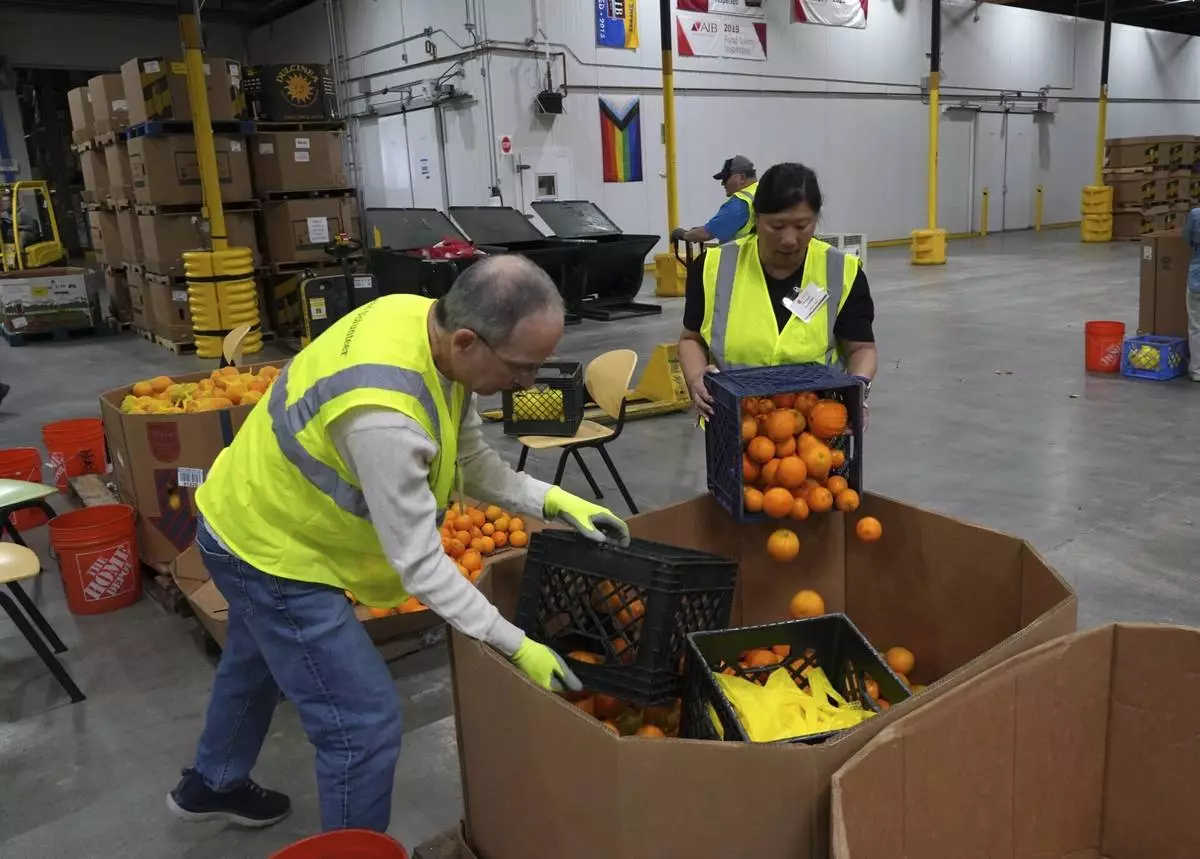
Volunteers pack produce at the Alameda County Community Food Bank in Alameda, Calif., on Friday, April 25, 2025. (AP Photo/Terry Chea)
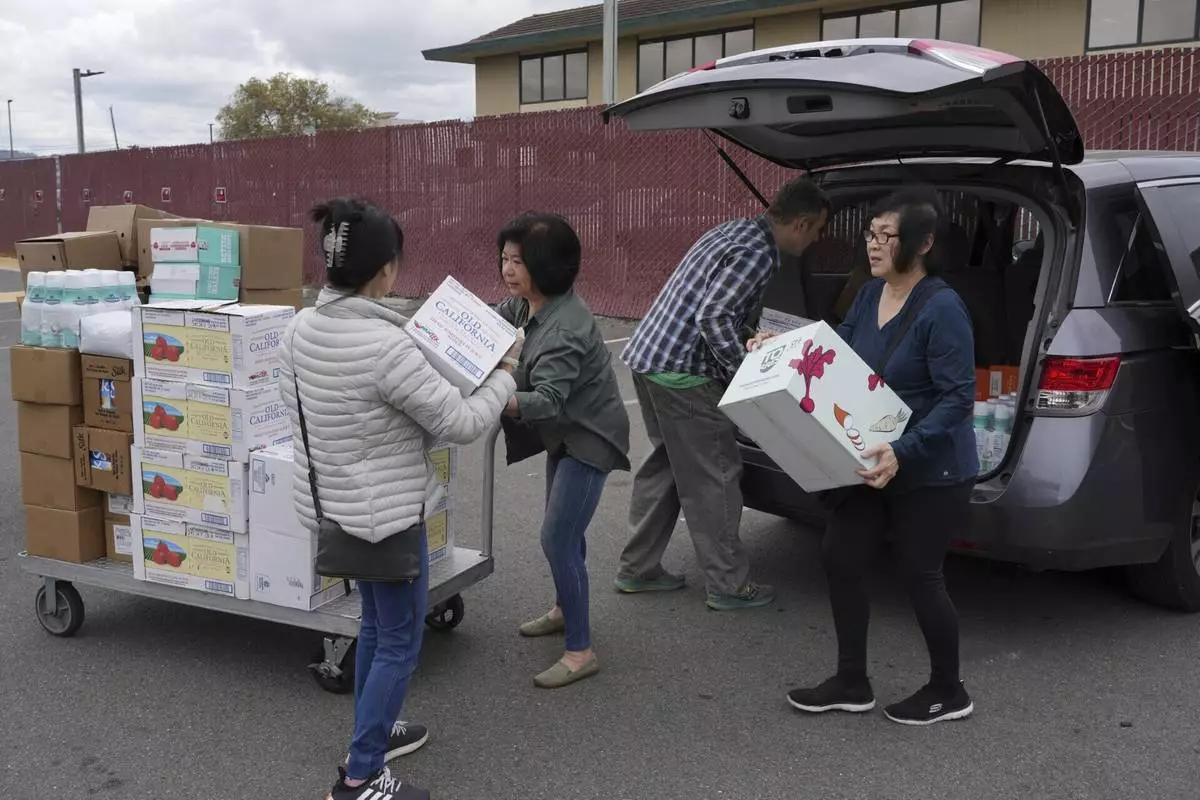
Church members pack groceries in van at the Alameda County Community Food Bank in Alameda, Calif., on Friday, April 25, 2025. (AP Photo/Terry Chea)
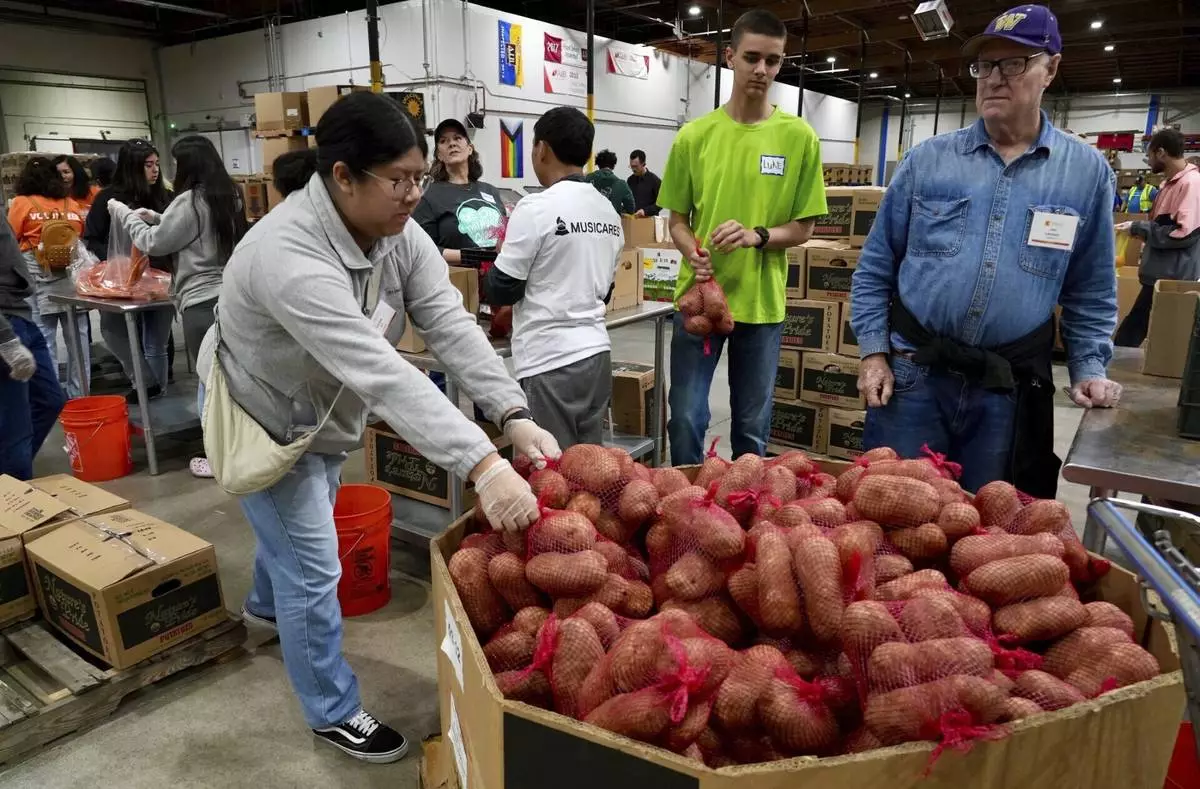
Volunteers pack produce at the Alameda County Community Food Bank in Alameda, Calif., on Friday, April 25, 2025. (AP Photo/Terry Chea)
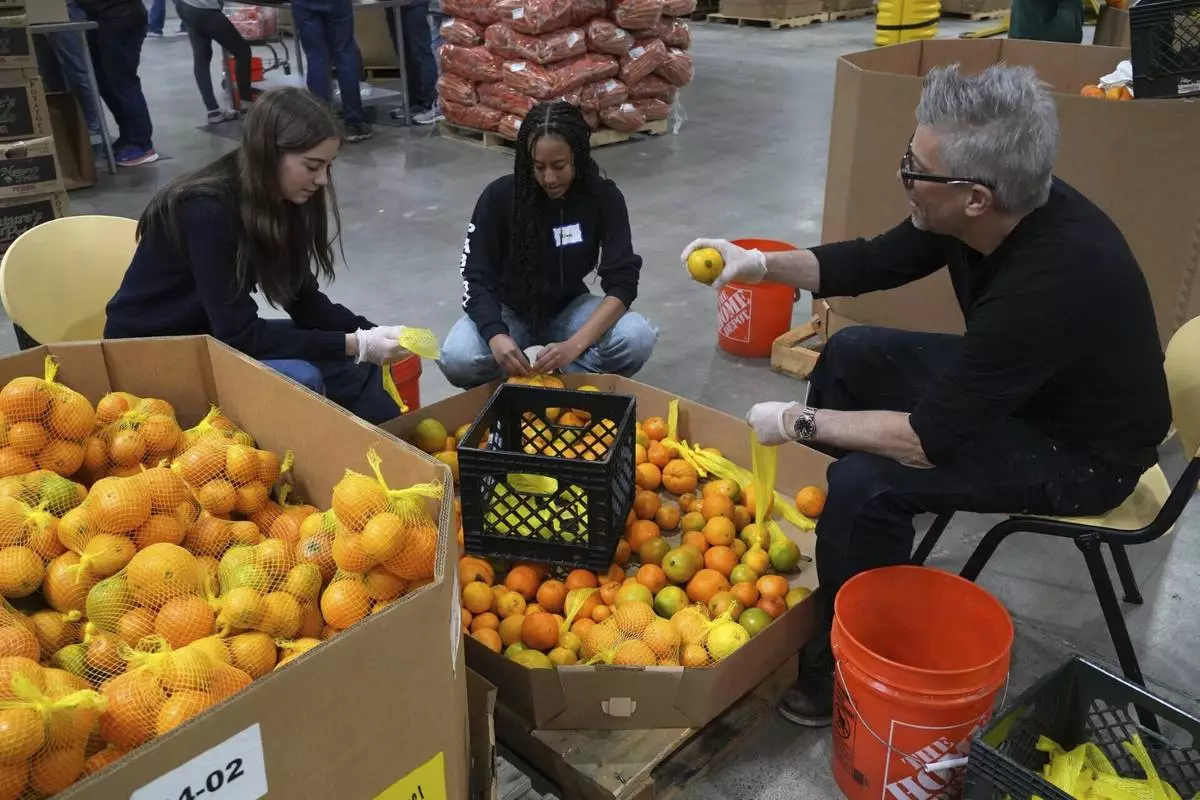
Volunteers pack produce at the Alameda County Community Food Bank in Alameda, Calif., on Friday, April 25, 2025. (AP Photo/Terry Chea)
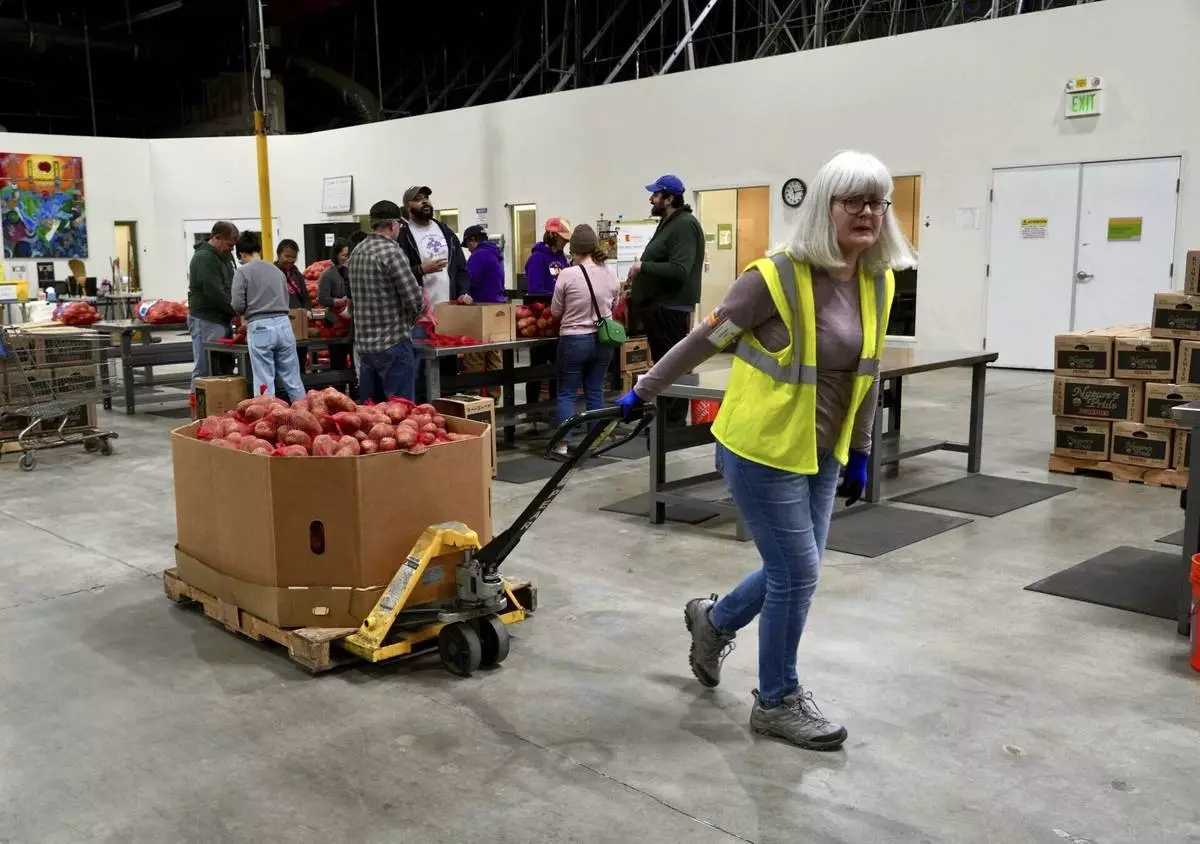
A volunteer pulls box of produce at the Alameda County Community Food Bank in Alameda, Calif., on Friday, April 25, 2025. (AP Photo/Terry Chea)

Volunteers pack produce at the Alameda County Community Food Bank in Alameda, Calif., on Friday, April 25, 2025. (AP Photo/Terry Chea)
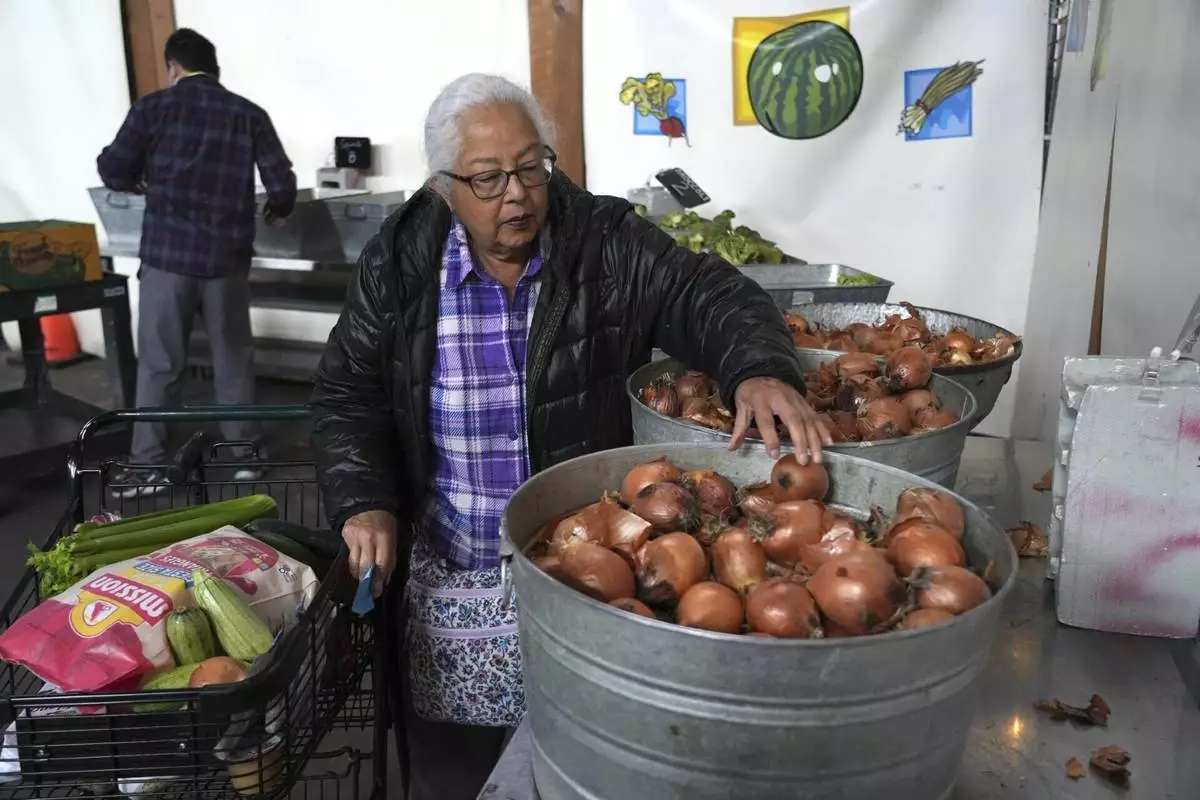
Alameda resident Beatriz Cortez picks up groceries at the Alameda Food Bank on Friday, April 25, 2025. (AP Photo/Terry Chea)
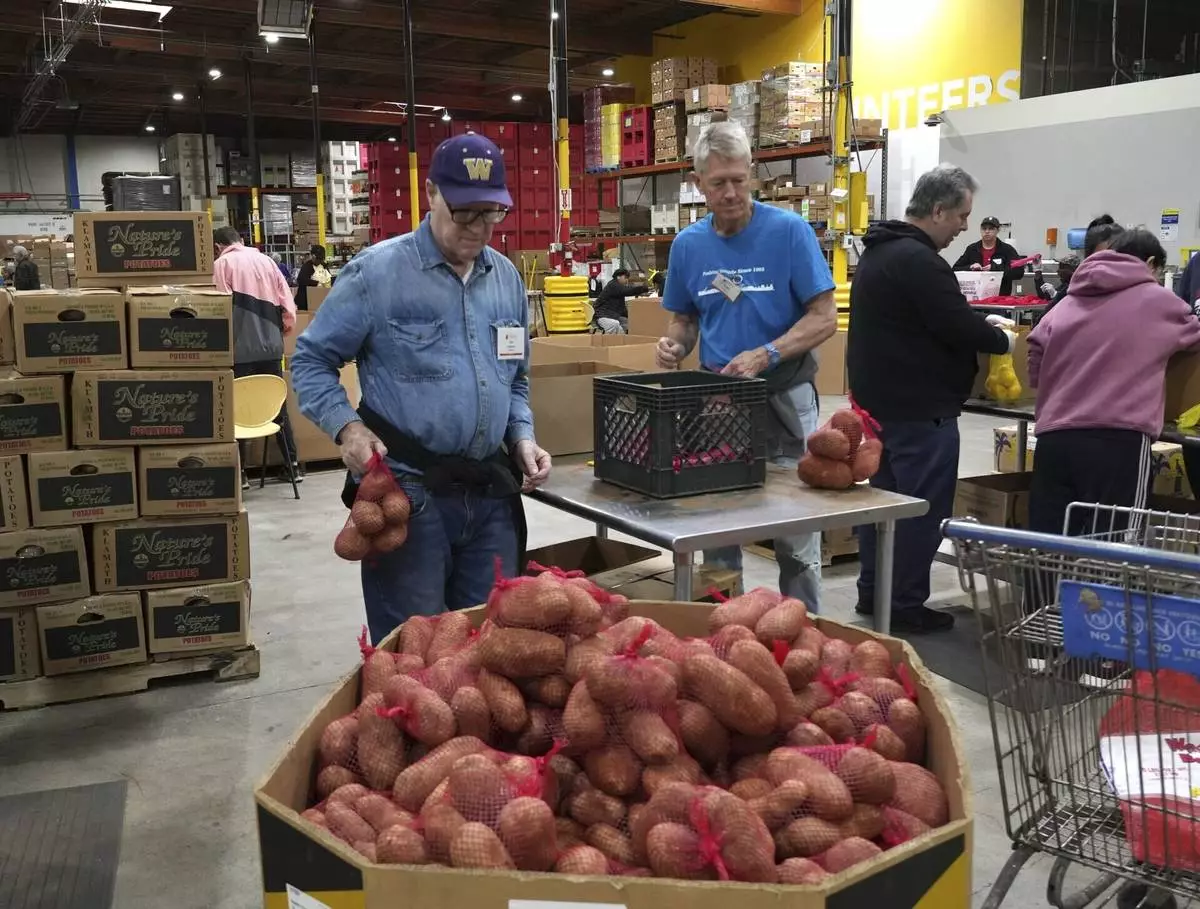
Volunteers pack produce at the Alameda County Community Food Bank in Alameda, Calif., on Friday, April 25, 2025. (AP Photo/Terry Chea)
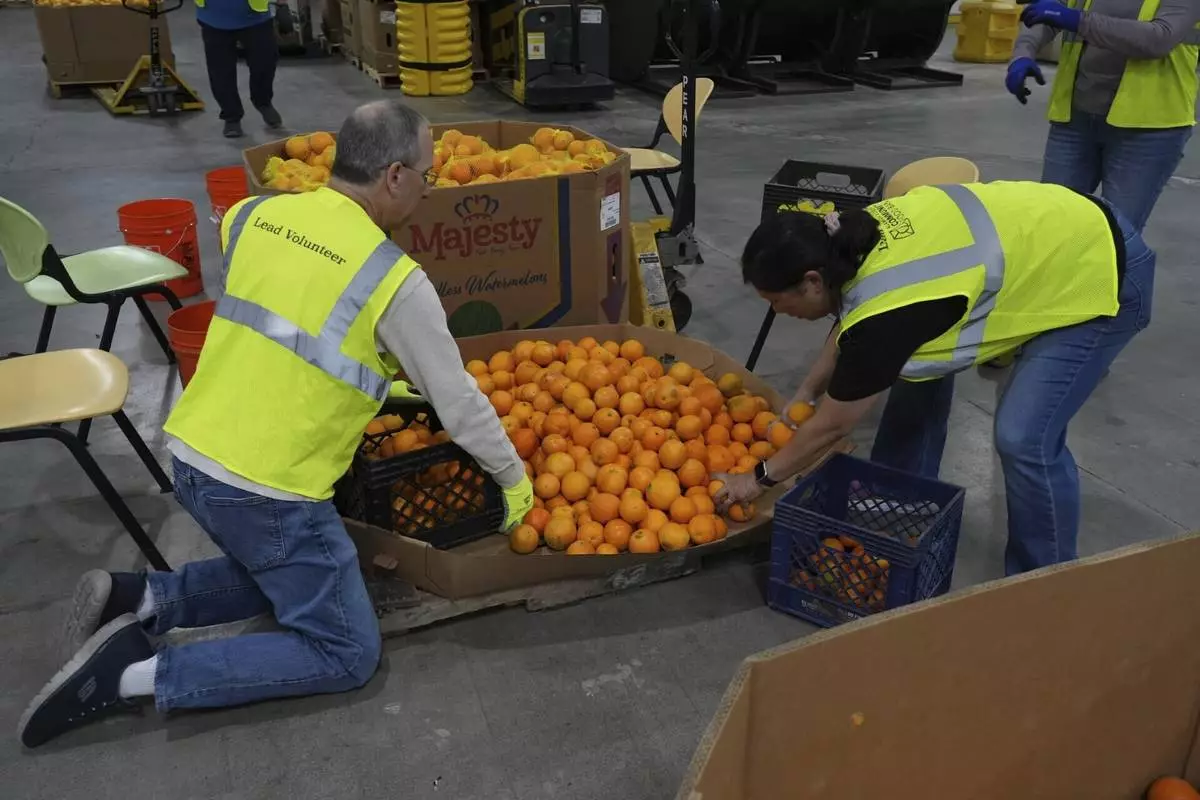
Volunteers pack produce at the Alameda County Community Food Bank in Alameda, Calif., on Friday, April 25, 2025. (AP Photo/Terry Chea)

Volunteers pack produce at the Alameda County Community Food Bank in Alameda, Calif., on Friday, April 25, 2025. (AP Photo/Terry Chea)
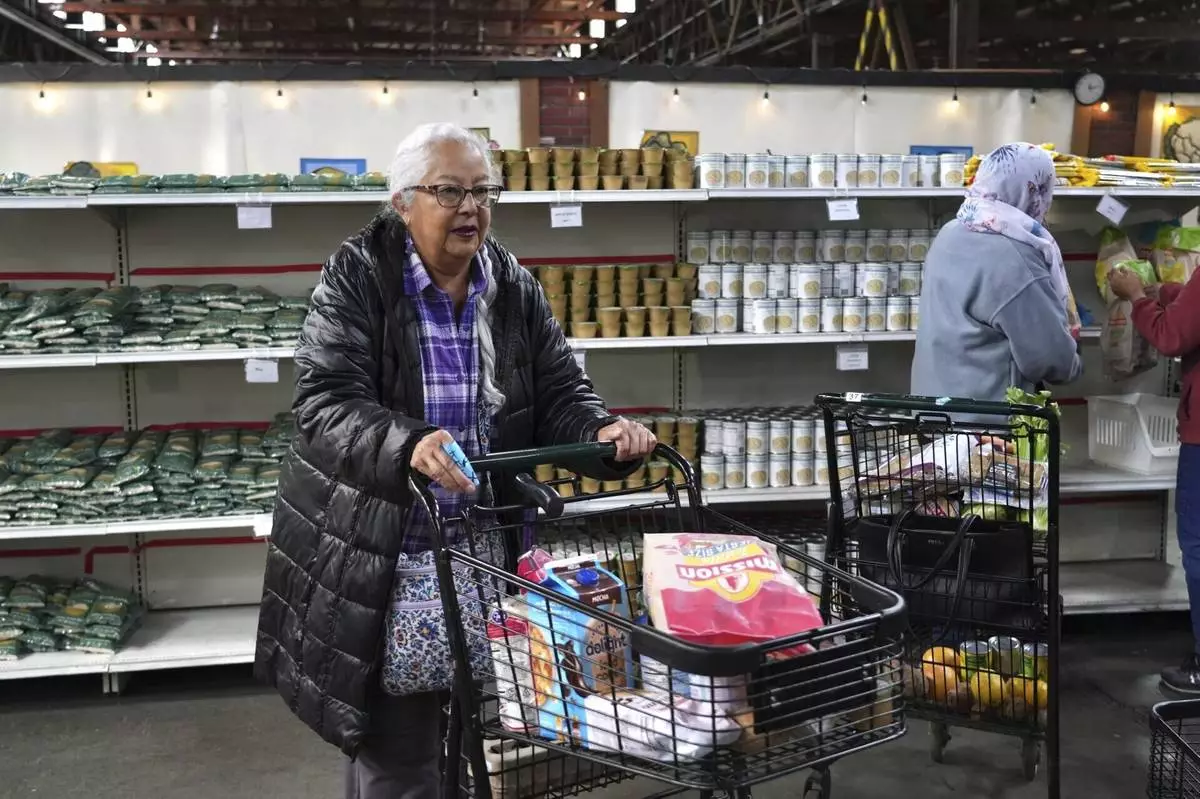
Alameda resident Beatriz Cortez picks up groceries at the Alameda Food Bank on Friday, April 25, 2025. (AP Photo/Terry Chea)
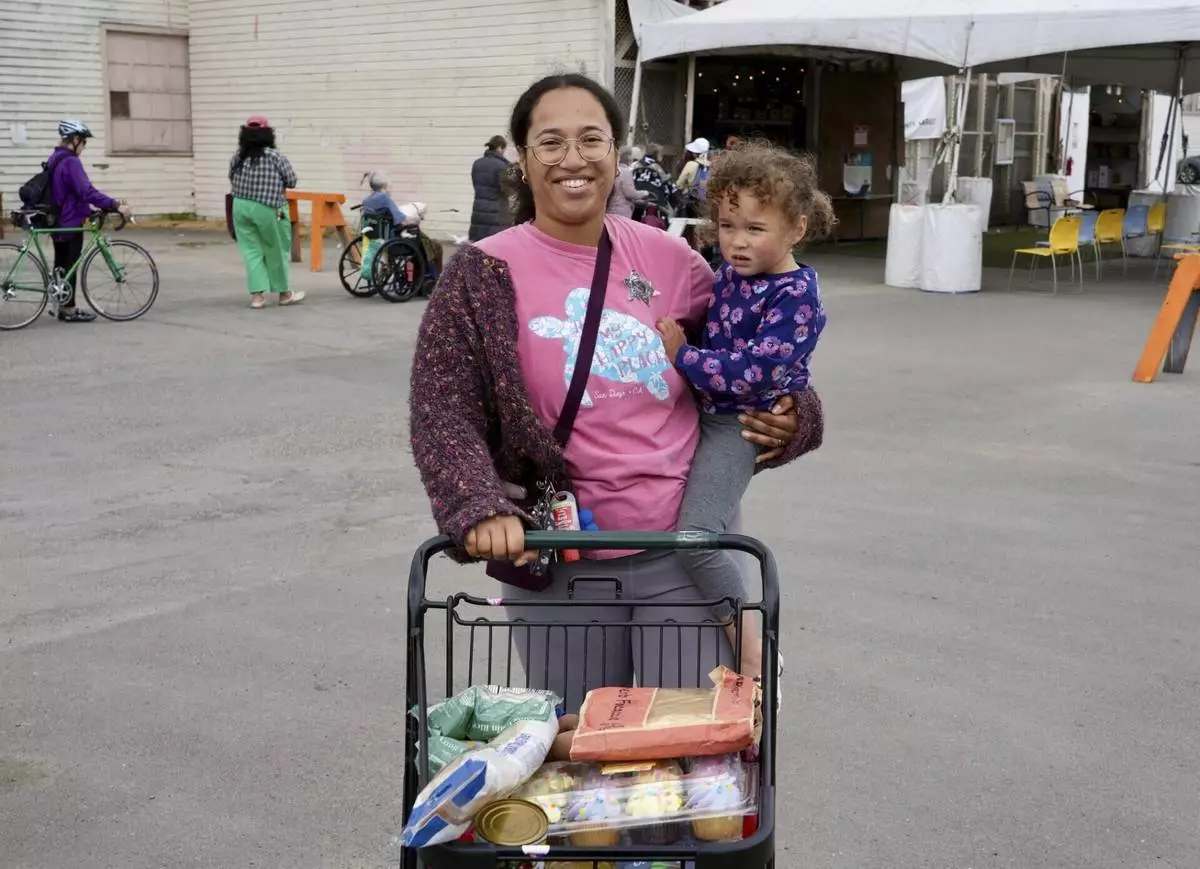
Alameda resident Christina Santamaria stands outside the Alameda Food Bank with groceries and her daughter in Alameda, Calif. on Friday, April 25, 2025. (AP Photo/Terry Chea)
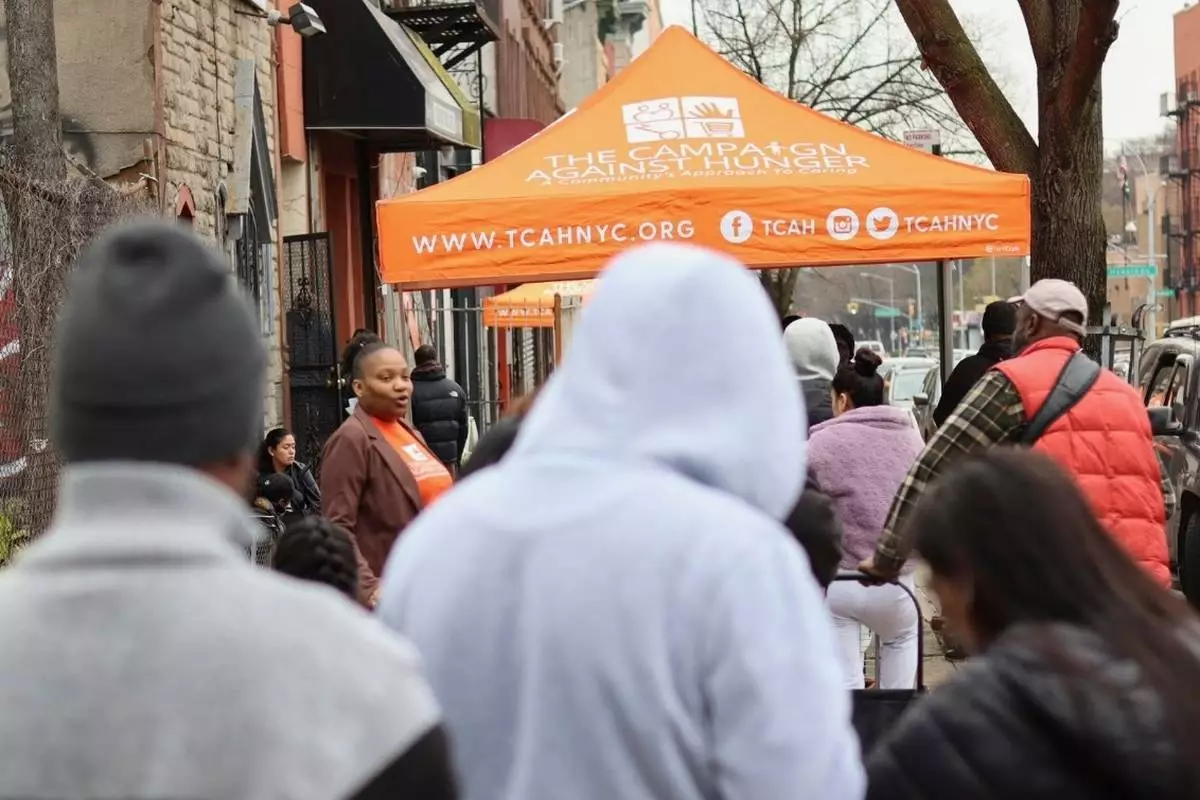
People line up for groceries outside The Campaign Against Hunger's distribution center in the Brooklyn borough of New York, Tuesday, April 15, 2025. (AP Photo/James Pollard)
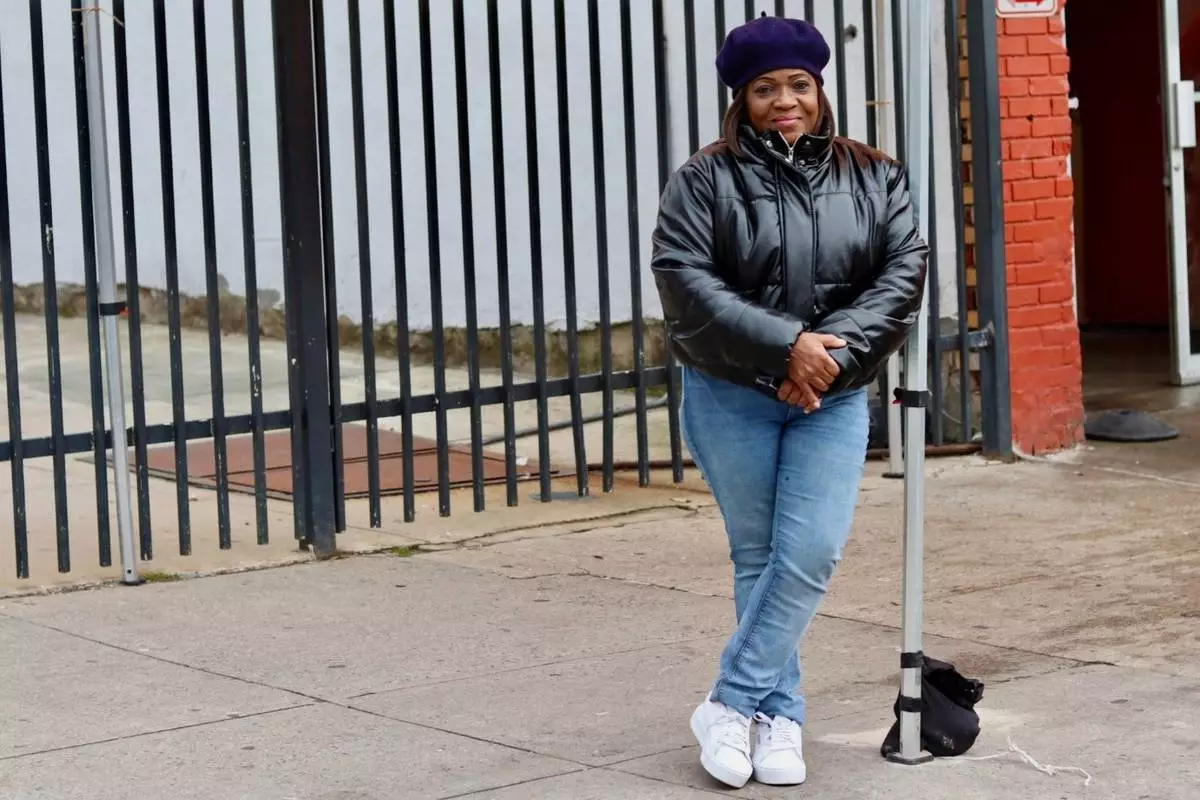
Kim Dennis, 65, visits The Campaign Against Hunger's distribution center in the Brooklyn borough of New York, Tuesday, April 15, 2025. (AP Photo/James Pollard)

The Campaign Against Hunger Executive Director Melony Samuels sits in her office in the Brooklyn borough of New York, Tuesday, April 15, 2025. (AP Photo/James Pollard)






















